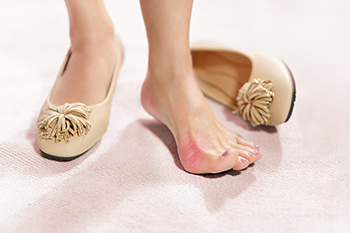
A hard lump on the side of the toe may be a bunion. It is considered to be a deformity, and large bunions may cause difficulty while wearing shoes. Women can be prone to developing bunions as a result of the high heels that are worn. They generally provide little room for the toes to move freely in, and this may cause the side of the big toe to rub on the shoe. Some patients notice their toes shifting toward each other, as the bunion may cause this misalignment. Corns and calluses may develop on top of the bunion, and putting a protective pad over it may bring relief. Pain may be caused by a bunion, and the toe may become numb or have a burning sensation. If you have developed a bunion, it is suggested that you speak to a podiatrist, who can offer you relief solutions, which may include minor surgery for removal.
If you are suffering from bunions, contact one of our podiatrists of Jill Einhorn, DPM and James Einhorn, DPM. Our doctors can provide the care you need to keep you pain-free and on your feet.
What Is a Bunion?
A bunion is formed of swollen tissue or an enlargement of boney growth, usually located at the base joint of the toe that connects to the foot. The swelling occurs due to the bones in the big toe shifting inward, which impacts the other toes of the foot. This causes the area around the base of the big toe to become inflamed and painful.
Why Do Bunions Form?
Genetics – Susceptibility to bunions are often hereditary
Stress on the feet – Poorly fitted and uncomfortable footwear that places stress on feet, such as heels, can worsen existing bunions
How Are Bunions Diagnosed?
Doctors often perform two tests – blood tests and x-rays – when trying to diagnose bunions, especially in the early stages of development. Blood tests help determine if the foot pain is being caused by something else, such as arthritis, while x-rays provide a clear picture of your bone structure to your doctor.
How Are Bunions Treated?
If you have any questions, please feel free to contact our offices located in Brooklyn and Astoria, NY . We offer the newest diagnostic and treatment technologies for all your foot care needs.